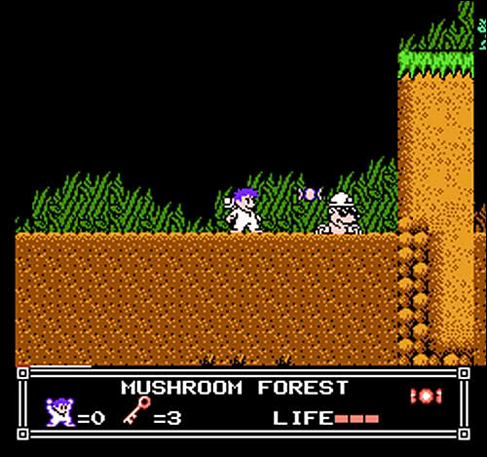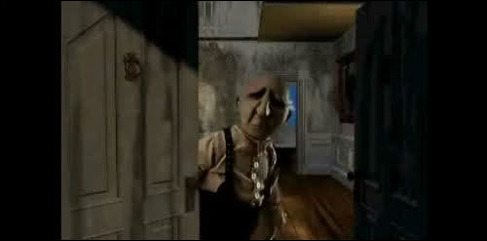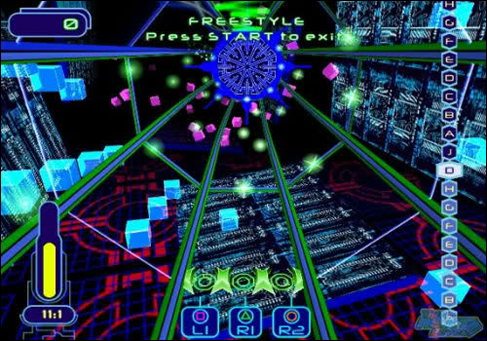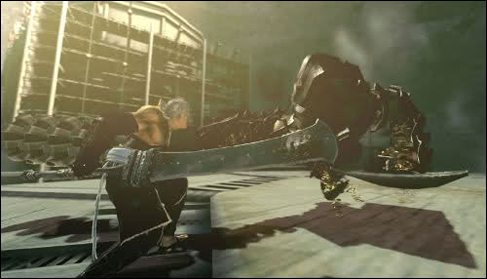The List: My Top 100 Favorite Video Games of All Time, part eight
By Damien Wilkens
08 June 2012 — You know what's cool? Video games. You know what I'm running out of? Intros.
#65 - Little Nemo: The Dream Master
System: NES
Originally released: 1990
What is it?
A really hard 8-bit platformer based on an anime that was, in turn, based on Windsor McCay's 1905 American comic strip Little Nemo in Slumberland. The strip was dark, surreal, haunting, and, at times, even violent. It was a work that influenced artists like Bill Watterson, Moebius, and even Walt Disney.
Following the tradition of Capcom platformers, it was a game with a simple, kid-friendly concept that betrayed the unrelenting challenge underneath. Playing as Nemo, you're tasked with finding keys throughout the levels to open the doors at the end. Since keys are often out of reach, Nemo has to use candy in exchange for the abilities of creatures he meets along the way.

Why did it make the list?
A lot of my love for the game comes from its source material, but it's also worth pointing out how cool it was that they made a game based on everything in the late 1980s and early 90s. While this resulted in a lot of unwise licensing choices, Capcom tended to be the smartest when it came to their adapted properties. Case in point, a video game originating from an early 20th century comic strip is something that absolutely could not happen today.
The game itself is home to unconventional concepts, not only in the art design, but the layout of the levels. Due to the key-finding nature of the game, verticality plays a bigger part than most games of the era, and it's a more nonlinear experience in general. Given the nature of the NES platformer, it's also really goddamn hard. Checkpoints are rare and enemies respawn constantly. Though technically skewed to a younger audience, the gameplay creates the same barrier that the comic and movie did, making it more for adults with a hint of whimsy than actual kids. As a whimsy-ridden adult, I can accept that.
Best Moment: Late in the game, Nemo finally gets ahold of an offensive weapon: a wand that you need to defeat the Nightmare King. After several hours of weak candy-tossing, it perfectly captures the childhood power fantasy that the final moments are made for.
Fun Fact: Little Nemo was the inspiration for Tom Petty's "Running Down a Dream" video. And with that, I've officially given you the only reason you've ever had to watch a Tom Petty video.
#64 - The Dark Eye
Systems: PC, Mac
Originally released: 1995
What is it?
An obscure mid-90s point-and-click adventure based on the works of Edgar Allan Poe. You are an unnamed man visiting your uncle, an eccentric old painter that lives in seclusion with his daughter. After accidentally inhaling some of his paint thinner, you find yourself drifting off into nightmarish reenactments of famous Poe stories like "The Tell-Tale Heart" and "Berenice."
While all of this is happening, there is another plot involving a relationship between your brother and your cousin. Yup.

Why did it make the list?
Surprisingly rare is the video game based on the works of Poe, considering his influence and popularity, but even more rare is the point-and-click adventure lacking any real puzzles to speak of. To even say that The Dark Eye has gameplay in the traditional sense would be kind of misleading, as you're more an audience for the story than an active participant. Though, your sanity does come into question when trying to figure out just why looking into the eye of a dead fish transports you to a literary nightmare world.
What makes The Dark Eye so appealing is its approach to storytelling. All of the characters are normal looking, save their demented clay figure heads with unmoving mouths, animated through janky stop motion that only serves to make the scenes more unnerving. Though limited in choices, you are free to move about the story at your own pace, and the lack of puzzles never feeling like a hinderance. It's actually quite telling that experimental games of the modern era, like Dear Esther, are just now seeing the potential in such a format. Sure, it's a game you'll only play once, but you're not likely to ever forget it.
Best Moment: The first nightmare sequence involves you reenacting "The Cask of Amontillado," first from the perspective of the victim, then the murderer.
Fun Fact: Thomas Dolby of "She Blinded Me with Science" sort-of fame composed the soundtrack, and William S. Burroughs voiced the uncle a mere two years before his death.
#63 - Frequency
System: PlayStation 2
Originally released: 2001
What is it?
Grandfather to Guitar Hero and Rock Band, Frequency was the first music game made by Harmonix. After being told that a music rhythm game couldn't succeed without a flashy peripheral, Harmonix took on the challenge and created what would be, in many ways, a prototype of their later successes.
Players advance along a track, hitting notes to complete a measure before moving on to the next instrument, slowly building the song from silence into fully realized composition. In place of colorful frets, you simply hit the shoulder buttons on a controller, or, if you've been blessed with superhuman thumbs, the face buttons.

Why did it make the list?
Though plastic instruments would later make for a more immersive experience, Frequency was still firmly entrenched in the realm of a game. It felt less about emulation of a performance than a race to survive, powered by music. The sheer sense of speed in some of the latter stages more resembles a shooter than a rhythm game, and given the electronic music leanings, the soundtrack does little to pull you out of your trance. Which isn't to say there aren't some good tunes (to this day, it's the only music game to feature The Jungle Brothers), it's just that the emphasis was less on big names and more on what would work in a game context.
What really sets the game apart and makes it worth revisiting is the surprisingly deep remix mode, wherein you can take the components of any song in the game and rearrange it any way you'd like, creating entirely new songs from them.
Best Moment: Pretty much any time I remixed Curve's "Worst Mistake." It was a thing of beauty. Take my word for it.
Fun Fact: Upcoming release Rock Band Blitz will, essentially, be a reskinned Frequency, though it will probably lack the remix mode.
#62 - Nier
Systems: PlayStation 3, Xbox 360
Originally released: 2010
What is it?
The final game from troubled Tokyo developer Cavia, and quite possibly the best Square Enix game of the past decade.
It's the story of a man with an unyielding devotion to his daughter, braving a strange land to find a cure for her illness, all while dealing with the Shades, aggressive creatures of unknown origin.

Why did it make the list?
If you haven't figured it out by now, I have a real soft spot for flawed games, most notably the kind that do one thing so astoundingly well that you can forgive just about anything else it throws in front of you. Nier has its problems, for sure. Graphically, it's nothing special, and the sidequests are some of the most tedious things I've ever been asked to do in a video game, but it crafts such a captivating story that you can't help but press on. You not only want to know the secrets of this world, by the narrative's end you need to.
There are also genuinely good ideas at work, as the game does a lot to break from traditional action RPG conventions; it pulls from other genres to create an experience all its own. It's not everyday that you see an action RPG crossed with a fishing game, a bullet-hell shooter, and a text adventure. In most cases, that's probably for the best, but here it's done with such love and reverence that you wonder how this could be the same studio that put out shovelware Wii games and handheld ports.
Best Moment: Late in the game you are faced with the truth about the world that Nier inhabits and where exactly all of the Shades came from. It's a gut-wrenching scene, leading you into a battle you're not entirely sure you want to win.
Fun Fact: Playing through the game four times prompts you to make an ultimate sacrifice, reflecting the consequences of your decision by erasing all of your save data forever.
#61 - The Path
Systems: PC, Mac
Originally released: 2009
What is it?
Based on the already-grim origins of "Little Red Riding Hood," The Path is an experimental horror game from Belgian developer Tale of Tales.
Six sisters are on their way to grandmother's house. There is only one rule, and it's a rule that must be broken: stay on the path.

Why did it make the list?
The Path isn't really a game that can be broken down into its individual parts in the hope of understanding why it works. Though the concept is simple enough to describe — six sisters venture into the woods and encounter their own version of the Big Bad Wolf — it's something that must be played to truly appreciate. I suppose the same could be said for the a lot of the lesser-known games I've mentioned so far, but The Path has mastered the one thing that's missing the most from modern gaming: subtlety. The information you get about each sister is limited to their age and physical appearance. As you examine items in the forest, they will comment, giving only the occasional glimpses into their individual personalities.
Though slow-paced and devoid of any real action, the atmosphere and tension throughout are so prevalent that it's hard not to get lost in the world and invested in the fates of each sister, stopping at every object of interest in the forest, formulating a story in the margins of what you've been told. It's the closest thing video gaming has ever gotten to a David Lynch film.
Best Moment: There is a breakthrough moment in each playthrough when you finally start to piece together the clues around you and figure out just what exactly is going on. I wouldn't dare spoil it for you.
Fun Fact: Tale of Tales is known for their avant-garde approach to game development. Their other titles include a game involving an old woman walking through a graveyard, and an MMO where you play as deer. They are fighting the good fight.
In the next addition of The List, things get weirder, scarier, and even a bit groovier.

